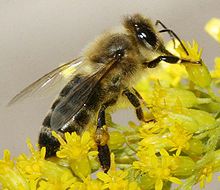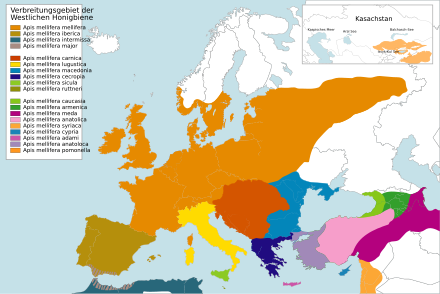Breeds of the western honey bee

Breeds of the western honey bee are different, partly domesticated and breeding-influenced populations of the species Apis mellifera . They are kept in beekeeping and are now common all over the world.
In the case of honey bees, for historical reasons, naturally occurring, morphologically distinguishable populations are sometimes referred to as “races”, which is currently only acceptable and common for domestic animal breeds . As for "geographic races" in general, however, the rank of a subspecies is increasingly gaining ground . The same units are therefore sometimes alternatively taken as a race or as a subspecies.
beekeeping
By transporting colonies of bees over long distances for use in beekeeping, humans have changed the distribution pattern of the various honeybee subspecies originally distributed as vicarious agents and, as a result of hybridization through bee transports, and for a few decades also through breeding, influenced their character. Through breeding, the natural subspecies and ecotypes that are traditionally widespread in the wild or kept as pets by beekeepers are genetically modified and their populations are therefore partially threatened.
The subspecies (in apiculture partly still, as is otherwise only usual for agricultural breeding lines, also called races) of the western honeybee (Apis mellifera) are naturally formed units, which are partly differently suitable for beekeeping, whereby people preferred some of them and also established outside of their natural range. Only recently have modern breeding lines existed (actual races, English breeds versus races for the geographic races). Sometimes, however, it is common to define breed standards for natural subspecies such as carnica , which blurs the differences.
The aim of honey bee breeding is to use artificial selection to reinforce the desired genetic properties of the honey bees and to weaken undesirable properties. The main aim is to increase the yield of honey and to breed peaceful bees with a low swarming instinct . For this purpose, breeding lines are set up in order to obtain almost pure- breeding offspring, in the beekeeping language one speaks of breeding lines or line breeding . It is essentially inbreeding , which increases the genetic distance to the natural, wild populations ( wild forms ). "Most living beings show a lower vitality when inbreeding ... [t] he bee even proves to be particularly susceptible here." Western honeybee lines generally cannot survive in the wild.
Beekeeping, which only began in the modern era, established breeding lines and strains, some of which are based on the intentional crossing . On the other hand, this always took place unintentionally, due to the coexistence of bee colonies of different useful races (natural hybridization).
Examples are:
- Buckfast bee: crossbreeding from different subspecies of the honey bee. Karl Kehrle ( brother Adam ) began working as a beekeeper assistant in the English Benedictine monastery of Buckfast Abbey in 1916 . Later Kehrle used conventional inbreeding, crossbreeding and selection in order to strengthen certain traits (e.g. collecting instinct, gentleness etc.) and to reduce others (e.g. swarm instinct).
- Africanized honeybees : Spectacular accident in honey bee research due to the unwanted release of East African highland bees in South America . Natural hybrids with European breeds farmed there were viable in the wild - also known as killer bees .
- Elgon bee : in Sweden as a special breeding line ( hybrid ) form from the East African mountain bee and the Buckfast bee .
In order to maintain or stabilize the desired pure-breeding inbred lines of honey bees, so-called pure-breeding areas with mating locations were established in the past . In the last few decades the possibility of artificial, instrumental insemination of queen bees has been added, which has significantly improved and simplified the possibilities of breeding. One consequence of this institutional displacement breeding is that the native dark European bee ( Apis mellifera mellifera ) is now on the list of endangered livestock breeds .
Subspecies
In beekeeping the imprecise term bee breed is used , in biology and agricultural science the technical terms population, subspecies or ecotype are used , especially with natural, wild honeybees. The species Western honeybees can be divided into groups that were traditionally considered "bee races", but are now mostly treated as subspecies. (The names chosen here (trinomials or three-part names in which a third name is added to the binomial for the species Apis mellifera ) denote subspecies according to the zoological nomenclature ):
The dark honey bees
- the dark European bee ( Apis mellifera mellifera Linnaeus, 1758), also called Braunelle or Mellifera, indigenous honeybee in northern, eastern and western Europe
- the Iberian bee ( Apis mellifera iberiensis Engel, 1999, syn. Apis mellifera iberica Goetze, 1964), also Spanish bee
- the tell bee ( Apis mellifera intermissa v. Buttel-Reepen, 1906)
- the reef bee ( Apis mellifera major Ruttner, 1975)
- the Sahara bee ( Apis mellifera sahariensis Baldensberger, 1922)
- the Maltese bee ( Apis mellifera ruttneri Sheppard, Arias, Grech & Meixner, 1997)
The Carnica group
- the Carinthian bee ( Apis mellifera carnica Pollmann, 1879), also known as Carniolan bee but mostly simply Carnica . Breed exported and used worldwide.
- the Italian bee ( Apis mellifera ligustica MM Spinola, 1806), also known as the Italian bee or Ligustica . Breed exported and used worldwide.
- the Macedonian bee ( Apis mellifera macedonica Ruttner, 1988)
- the southern Greek bee ( Apis mellifera cecropia Kiesenwetter, 1860)
- the anatolian bee ( Apis mellifera anatoliaca Maa, 1953)
- the Sicilian bee ( Apis mellifera siciliana Grassi, 1881, also incorrectly called Apis mellifera sicula Montagano, 1911)
The bees of tropical Africa
- the East African highland bee ( Apis mellifera scutellata Lepeletier, 1836)
- the East African mountain bee ( Apis mellifera monticola Smith, 1849) (more docile than A. m. scutellata , inhabits rainy forests of East Africa at altitudes of 2,400 to 3,000 meters)
- the cape bee ( Apis mellifera capensis Escholz, 1821)
- the Egyptian bee ( Apis mellifera lamarckii Cockerell, 1906)
- the Arabian bee ( Apis mellifera yemenitica Ruttner, 1975)
- the East African coastal bee ( Apis mellifera litorea Smith, 1961)
- the West African bee ( Apis mellifera adansonii Latreille, 1804)
- the Madagascar bee ( Apis mellifera unicolor Latreille, 1804)
The bees of the Middle East
- the Caucasian bee ( Apis mellifera caucasica Gorbachew, 1916) Breed exported and used worldwide.
- the Armenian bee ( Apis mellifera armeniaca Skorikov, 1929)
- the Persian bee ( Apis mellifera meda Skorikov, 1929)
- the Syrian bee ( Apis mellifera syriaca v.Buttel-Reepen, 1906)
- the Cypriot bee ( Apis mellifera cypria Pollmann, 1879)
- the Cretan bee ( Apis mellifera adami Ruttner, 1975)
A subspecies in Central Asia
- Apis mellifera pomonella Sheppard & Meixner, 2003
literature
- Heinrich Friese : The bees of Europe ( Apidae europaeae) . Akademische Druck- und Verlagsanstalt, Graz 1969 (reprint of the first edition 1895-1901).
- Michael S. Engel : The taxonomy of recent and fossil honey bees (Hymenoptera: Apidae: Apis). Journal of Hymenoptera Research 8, 1999.
Individual evidence
- ↑ also for other species of the genus Apis , cf. Rakesh Kumar Gupta: Taxonomy and Distribution of Different Honeybee Species. Chapter 2 in Rakesh Kumar Gupta, Wim Reybroeck, Johan W. van Veen, Anuradha Gupta (editors): Beekeeping for Poverty Alleviation and Livelihood Security: Vol. 1: Technological Aspects of Beekeeping. Springer Verlag, Dordrecht etc., 2014. ISBN 978-9401791984 .
- ↑ Marina D Meixner, Maria Alice Pinto, Maria Bouga, Per Kryger, Evgeniya Ivanova, Stefan Fuchs (2013): Standard methods for characterizing subspecies and ecotypes of Apis mellifera. Journal of Apicultural Research 52 (4): 1-28. doi: 10.3896 / IBRA.1.52.4.05
- ↑ R. Moosbeckhofer: Indigenous bee races in Austria. In the Austrian Chamber of Agriculture and the Rural Training Institute Austria (publisher): Biodiversität. Contribution of agriculture and forestry to the conservation of biodiversity. Vienna, March 2009.
- ^ Friedrich-Karl Tiesler, Kaspar Bienefeld, Ralph Büchler: Selection in the honeybee , 1st edition, new edition. Edition, Buschhausen Druck- und verlagshaus, Herten 2016, ISBN 9783946030454 , p. 59 (accessed on 29 September 2019).
- ↑ Dark bee . Society for the preservation of old and endangered domestic animal breeds e. V .. Retrieved September 29, 2019.
- ↑ Friedrich Ruttner: Natural history of honey bees. Franckh Kosmos Verlag, Stuttgart 1992, ISBN 3-440-09125-2 .
- ^ Friedrich Ruttner: Biogeography and Taxonomy of Honeybees. Springer Verlag, Berlin etc. 1988. ISBN 978-3-642-72651-4 , pp. 76-78.
- ↑ Karl Kehrle: Africa's bees - a challenge for progressive breeding General German beekeeping newspaper ADIZ 1988 22 (8) 277-278 and (9) 300-302.

